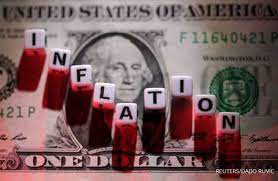
According to a metric the central bank views as its more significant barometer, US inflation increased in February in line with predictions, perhaps keeping the Federal Reserve on hold until it can start thinking about cutting interest rates.
The Commerce Department released a report on Friday that showed a 2.8% 12-month increase in the personal consumption expenditures price index, which excludes food and energy, and a 0.3% increase from one month prior. The figures were in line with the Dow Jones projections.
The headline PCE data, which includes volatile food and energy expenses, indicated a 0.3% increase for the month and a 2.5% increase at the 12-month rate, as opposed to predictions of 0.4% and 2.5%.
In honour of Good Friday, the bond and stock markets were both closed.
The Fed views core as a more accurate indicator of long-term inflation pressures, even though it analyses both indicators when determining policy. The core PCE inflation rate has not fallen below the 2% annual inflation objective set by the Fed for the past three years.
“Nothing really super surprising. Obviously not the numbers the Fed wants to see, but I don’t think this is going to catch anybody off guard when they come back to work on Monday,” Victoria Greene, chief investment officer at G Squared Private Wealth, said.
“I think everybody is going to pivot to labor pretty quickly and say well maybe if we see some weakness and cracks over here, this little stickiness in inflation and PCE isn’t going to matter as much.”
With a 2.3% rise, rising energy prices contributed to the headline reading. Food index increased by 0.1%. The 0.5% increase in commodities and the 0.3% increase in services contributed more to inflation pressures. This went against the pattern of the previous year, which saw a 3.8% increase in services and a 0.2% decline in products.
Financial services, insurance, air travel, and international travel agencies all put upward pressure on prices. The category with the largest contribution on the goods side was motor vehicles and parts.
Consumer expenditure increased by 0.8% for the month in addition to the increase in inflation, significantly exceeding the 0.5% forecast and perhaps signalling further price pressures. Personal income grew by 0.3%, which was a little less than the predicted 0.4%.
The announcement was made a little over a week after the central bank maintained the stability of its benchmark short-term borrowing rate once more and stated that it has not yet witnessed enough inflation to contemplate lowering it. The Federal Open Market Committee members reiterated their three quarter-percentage point decreases this year and in 2025 in their quarterly update of rate estimates.
When the Fed announces its decision on May 1, the markets anticipate that it will stay on hold once more and start reducing at the June 11–12 meeting. The CME Group's FedWatch measure of futures market movement indicates that market pricing is in line with FOMC estimates for three cuts.
(Source:www.fxempire.com)
The Commerce Department released a report on Friday that showed a 2.8% 12-month increase in the personal consumption expenditures price index, which excludes food and energy, and a 0.3% increase from one month prior. The figures were in line with the Dow Jones projections.
The headline PCE data, which includes volatile food and energy expenses, indicated a 0.3% increase for the month and a 2.5% increase at the 12-month rate, as opposed to predictions of 0.4% and 2.5%.
In honour of Good Friday, the bond and stock markets were both closed.
The Fed views core as a more accurate indicator of long-term inflation pressures, even though it analyses both indicators when determining policy. The core PCE inflation rate has not fallen below the 2% annual inflation objective set by the Fed for the past three years.
“Nothing really super surprising. Obviously not the numbers the Fed wants to see, but I don’t think this is going to catch anybody off guard when they come back to work on Monday,” Victoria Greene, chief investment officer at G Squared Private Wealth, said.
“I think everybody is going to pivot to labor pretty quickly and say well maybe if we see some weakness and cracks over here, this little stickiness in inflation and PCE isn’t going to matter as much.”
With a 2.3% rise, rising energy prices contributed to the headline reading. Food index increased by 0.1%. The 0.5% increase in commodities and the 0.3% increase in services contributed more to inflation pressures. This went against the pattern of the previous year, which saw a 3.8% increase in services and a 0.2% decline in products.
Financial services, insurance, air travel, and international travel agencies all put upward pressure on prices. The category with the largest contribution on the goods side was motor vehicles and parts.
Consumer expenditure increased by 0.8% for the month in addition to the increase in inflation, significantly exceeding the 0.5% forecast and perhaps signalling further price pressures. Personal income grew by 0.3%, which was a little less than the predicted 0.4%.
The announcement was made a little over a week after the central bank maintained the stability of its benchmark short-term borrowing rate once more and stated that it has not yet witnessed enough inflation to contemplate lowering it. The Federal Open Market Committee members reiterated their three quarter-percentage point decreases this year and in 2025 in their quarterly update of rate estimates.
When the Fed announces its decision on May 1, the markets anticipate that it will stay on hold once more and start reducing at the June 11–12 meeting. The CME Group's FedWatch measure of futures market movement indicates that market pricing is in line with FOMC estimates for three cuts.
(Source:www.fxempire.com)





